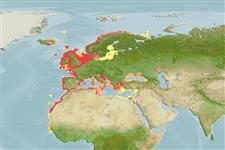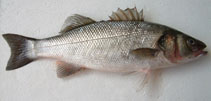Dicentrarchus labrax (Linnaeus, 1758)
European seabass
添加你自己的观测位置在 Fish Watcher
| Native range | All suitable habitat | Point map | Year 2050 |

|
| This map was computer-generated and has not yet been reviewed. |
| Dicentrarchus labrax AquaMaps Data sources: GBIF OBIS |
Italy country information
Common names:
Baicolo, Brancin, Branzin
Occurrence: native
Salinity: freshwater
Abundance: | Ref:
Importance: minor commercial | Ref: FAO, 1994
Aquaculture: commercial | Ref: FAO Fishery Information, Data and Statistics Service, 1993
Regulations: | Ref:
Uses: no uses
Comments: Recorded from Soca estuary (Ref. 59043).
National Checklist:
Country Information: https://www.cia.gov/library/publications/resources/the-world-factbook/geos/it.html
National Fisheries Authority:
Occurrences: Occurrences Point map
Main Ref: Bauchot, M.-L., 1987
National Database: ICTIMED
Occurrence: native
Salinity: freshwater
Abundance: | Ref:
Importance: minor commercial | Ref: FAO, 1994
Aquaculture: commercial | Ref: FAO Fishery Information, Data and Statistics Service, 1993
Regulations: | Ref:
Uses: no uses
Comments: Recorded from Soca estuary (Ref. 59043).
National Checklist:
Country Information: https://www.cia.gov/library/publications/resources/the-world-factbook/geos/it.html
National Fisheries Authority:
Occurrences: Occurrences Point map
Main Ref: Bauchot, M.-L., 1987
National Database: ICTIMED
Common names from other countries
分类 / Names 俗名 | 同种异名 | Catalog of Fishes(属, 种) | ITIS | CoL | WoRMS | Cloffa
Teleostei > Eupercaria/misc (Various families in series Eupercaria) > Moronidae (Temperate basses)
Etymology: Dicentrarchus: Greek, di = two + Greek, kentron = sting + Greek, archos = anus (Ref. 45335).
More on author: Linnaeus.
Etymology: Dicentrarchus: Greek, di = two + Greek, kentron = sting + Greek, archos = anus (Ref. 45335).
More on author: Linnaeus.
Environment: milieu / climate zone / depth range / distribution range 生态学
海洋; 淡水; 半咸淡水 居于水底的; 海洋洄游的; 深度上下限 10 - 100 m (Ref. 9987). 亞熱帶的; 8°C - 24°C (Ref. 4944); 72°N - 11°N, 19°W - 42°E (Ref. 54221)
分布 国家 | FAO区域 | 生态系 | 标本纪录 | Point map | 简介 | Faunafri
Eastern Atlantic: Norway to Morocco, the Canary Islands and Senegal. Also known from the Mediterranean and Black Sea. Absent from White, Barents, Baltic and Caspian Seas (Ref. 59043).
東大西洋: 挪威到摩洛哥, 加納利群島與塞內加爾。 記錄來自冰島了。 (參考文獻 12462) 也已知來自地中海與黑海。
東大西洋: 挪威到摩洛哥, 加納利群島與塞內加爾。 記錄來自冰島了。 (參考文獻 12462) 也已知來自地中海與黑海。
Length at first maturity / 大小 / 重量 / 年龄
Maturity: Lm 36.1, range 23 - 46 cm
Max length : 103 cm TL 雄鱼/尚未辨别雌雄; (Ref. 40637); common length : 50.0 cm TL 雄鱼/尚未辨别雌雄; (Ref. 6916); 最大体重: 12.0 kg (Ref. 1468); 最大年龄: 30 年 (Ref. 59043)
Max length : 103 cm TL 雄鱼/尚未辨别雌雄; (Ref. 40637); common length : 50.0 cm TL 雄鱼/尚未辨别雌雄; (Ref. 6916); 最大体重: 12.0 kg (Ref. 1468); 最大年龄: 30 年 (Ref. 59043)
简单描述 检索表 | 型态特徵 | 形态测量图
背棘 (总数) : 8 - 10; 背的软条 (总数) : 12 - 13; 臀棘: 3; 臀鳍软条: 10 - 12. Diagnosis: head with cycloid scales above; mouth moderately protractile (Ref. 231). Vomerine teeth only anteriorly (Ref. 231), in a crescentic band (Ref. 231, 57391). Scales on interorbital space cycloid (Ref. 57391). Posterior edge of opercle finely serrated, lower edge with strong forward- directed denticles (Ref. 231). 2 flat opercular spines (Ref. 231, 57391). Young with some dark spots on upper part of body (Ref. 231).
鳃盖的后缘细锯齿状的, 下缘有强的朝向前的细齿。 2根平坦的鳃盖棘。 嘴一般可伸出。 在身体的上半部上幼鱼有一些深色斑点。 头部有圆形的鳞片上方。 犁骨齿只有前面地, 在一条新月形的条纹中。
鳃盖的后缘细锯齿状的, 下缘有强的朝向前的细齿。 2根平坦的鳃盖棘。 嘴一般可伸出。 在身体的上半部上幼鱼有一些深色斑点。 头部有圆形的鳞片上方。 犁骨齿只有前面地, 在一条新月形的条纹中。
Adults manifest demersal behavior, inhabit coastal waters down to about 100 m depth but more common in shallow waters (Ref. 54221, 57391). Found in the littoral zone on various kinds of bottoms on estuaries, lagoons and occasionally rivers. They enter coastal waters and river mouths in summer, but migrate offshore in colder weather and occur in deep water during winter in the northern range. Young fish form school, but adults appear to be less gregarious (Ref. 9987). Feed chiefly on shrimps and mollusks, also on fishes (Ref. 5990). Juveniles feed on invertebrates, taking increasingly more fish with age. Adults piscivorous . (Ref. 59043). Spawn in batches (Ref. 51846). Spawning takes place in the spring near the British Isles, and earlier in its southern range. Eggs are pelagic (Ref. 35388). Marketed fresh or smoked (Ref. 9987). Highly sought by sport fishermen (Ref. 30578).
底栖行为, 居住于沿岸水域向下至大约 100 公尺深但是较常见于浅水域.(参考文献 54221) 在河口上的各种不同类型的底部上栖息于海滨的区域, 舄湖与偶然地河。 在夏天进入沿岸水域与河口, 但是移动较寒冷的天气的外海而且在北方的范围中在冬天期间出现于深水域中。 幼鱼形成鱼群,但是成鱼状似比较不群居.(参考文献 9987) 主要捕食虾与软件动物,也吃鱼。 (参考文献 5990) 在市场上销售新鲜或熏制。 (参考文献 9987) 深受运动钓鱼者企求。 (参考文献 30578) 产卵,发生于春天在英國人的附近成為島嶼, 與比較早的在它的南方範圍中。 卵是大洋性的。 (參考文獻 35388)
底栖行为, 居住于沿岸水域向下至大约 100 公尺深但是较常见于浅水域.(参考文献 54221) 在河口上的各种不同类型的底部上栖息于海滨的区域, 舄湖与偶然地河。 在夏天进入沿岸水域与河口, 但是移动较寒冷的天气的外海而且在北方的范围中在冬天期间出现于深水域中。 幼鱼形成鱼群,但是成鱼状似比较不群居.(参考文献 9987) 主要捕食虾与软件动物,也吃鱼。 (参考文献 5990) 在市场上销售新鲜或熏制。 (参考文献 9987) 深受运动钓鱼者企求。 (参考文献 30578) 产卵,发生于春天在英國人的附近成為島嶼, 與比較早的在它的南方範圍中。 卵是大洋性的。 (參考文獻 35388)
Life cycle and mating behavior 成熟度 | 繁殖 | 产卵场 | 卵 | 孕卵数 | 仔鱼
Spawn in groups. Eggs are pelagic. In the Mediterranean, first sexual maturity occurs generally between 2 and 4 years of age while in the Atlantic sexual maturity happens a little later (males between 4-7 years and females between 5-8 years). Spawning happens just once a year and it tends to be in winter, although in southern areas it can occur in spring. Eggs have 1-2 fat drops that fuse about 12 hours after laying. Embryo development lasts about three days at 13-14°C and larval development about 40 days at 19°C. Egg size 1.1-1.5 mm, larval length at hatching 3 mm.東大西洋: 挪威到摩洛哥, 加納利群島與塞內加爾。 記錄來自冰島了。 (參考文獻 12462) 也已知來自地中海與黑海。
主要参考文献
Upload your references | 参考文献 | 合作者 : Heemstra, Phillip C. | 合作者
Smith, C.L., 1990. Moronidae. p. 692-694. In J.C. Quero, J.C. Hureau, C. Karrer, A. Post and L. Saldanha (eds.) Check-list of the fishes of the eastern tropical Atlantic (CLOFETA). JNICT, Lisbon; SEI, Paris; and UNESCO, Paris. Vol. 2. (Ref. 6916)
对人类的威胁
无害处的
人类利用
渔业: 商业性; 养殖: 商业性; 游钓鱼种: 是的
更多信息
Population dynamics
成长参数
Max. ages / sizes
Length-weight rel.
Length-length rel.
体长-频率
Mass conversion
入添量
丰度
成长参数
Max. ages / sizes
Length-weight rel.
Length-length rel.
体长-频率
Mass conversion
入添量
丰度
Physiology
Body composition
Nutrients
耗氧量
游泳类型
游泳速度
Visual pigments
Fish sound
Diseases & Parasites
Toxicity (LC50s)
Body composition
Nutrients
耗氧量
游泳类型
游泳速度
Visual pigments
Fish sound
Diseases & Parasites
Toxicity (LC50s)
工具
E-book | 野外调查 | 检索表 | 长度- 频率 Wizard | 生活- 历史的工具 | 分布图 | Classification Tree
| Catch-MSY |
特别资料
下载 XML
网络资源
Alien/Invasive Species database | Aquatic Commons | BHL | Cloffa | Websites from users | 核实 FishWatcher | CISTI | Catalog of Fishes(属, 种) | DiscoverLife | DORIS | ECOTOX | Faunafri | Fishtrace | GenBank(基因组, 核苷酸) | GloBI | GOBASE | | Google Books | Google Scholar | Google | IGFA World Record | MitoFish | 国家资料库 | OsteoBase(skull, spine) | Otolith Atlas of Taiwan Fishes | 公众的水族馆 | PubMed | Reef Life Survey | Scirus | SeaLifeBase | 树状分类阶层 | Wikipedia(转至, 搜寻) | World Records Freshwater Fishing | 动物学的记录
Estimates based on models
Preferred temperature (Ref. 115969): 7.3 - 19.5, mean 10.7 (based on 788 cells).
Phylogenetic diversity index (Ref. 82804): PD50 = 0.7656 [Uniqueness, from 0.5 = low to 2.0 = high].
Bayesian length-weight: a=0.00933 (0.00780 - 0.01117), b=3.02 (2.97 - 3.07), in cm Total Length, based on LWR estimates for this species (Ref. 93245).
营养阶层 (Ref. 69278): 3.5 ±0.50 se; based on food items.
回复力 (Ref. 120179): 中等的, 族群倍增时间最少 1.4 - 4.4年 (K=0.06-0.33; tm=2-8; tmax=30; Fec=230,000).
Prior r = 0.37, 95% CL = 0.25 - 0.56, Based on 10 full stock assessments.
Fishing Vulnerability (Ref. 59153): High to very high vulnerability (66 of 100).
Climate Vulnerability (Ref. 125649): Moderate to high vulnerability (47 of 100).




